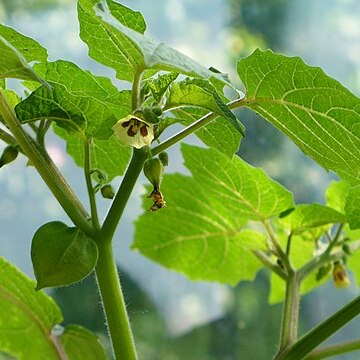Corolla yellow or greenish-yellow, blotched with 5 dark brownish violet or purplish markings strongly contrasting with the surrounding limb, sometimes spreading downwards and somewhat along the nerves upwards, 4–7(8) mm long, rotate; tube subglabrous, furnished with few ± sessile glands, on the inside with felted indumentum near the insertion of the stamens and with a ring of hyaline hairs at the mouth; limb (5)6–9 mm across, shortly 5-lobed, erect to widely spreading, sometimes reflexed when fully expanded, on the outside with ± appressed, short hairs and also sessile glands often along the nerves, on the median region of each lobe on the part not folded in bud, glabrous inside except for the lobes with minute hairs towards the apex, slightly ciliate.
Leaves usually solitary; petiole (0.3)1–4(4.5) cm long, often slightly winged, rather sheathing at the base; lamina membranous or ± fleshy, (1)2–11 × (0.5)1–5.5 cm, ovate or ovate-lanceolate, occasionally ovate-deltate, rhombic, elliptic or oblong, base obtuse, cuneate or attenuate, and often unequal-sided or dimidiate, decurrent into the petiole, apex acute, occasionally sub-acute or ± acuminate, sinuate-dentate or dentate, the teeth unequal, rather obtuse or rarely sub-acute, the sinuses ± deep, obtuse, glabrous except where decurrent on the petiole, sometimes with a few, often short, appressed hairs on the nerves and near the margins, occasionally scattered elsewhere.
Annual to 50 cm high, sparsely pubescent with minute, simple hairs, or glabrescent. Leaves alternate, 1 or 2 per node (but not opposite); lamina ovate-lanceolate, cuneate at base, usually c. 6 cm long, 3 cm wide, sometimes larger irregularly toothed or lobed; petiole to 6 cm long. Pedicels 6–10 mm long. Calyx 3.5–5 mm long; lobes triangular, 1–2 mm long. Corolla broadly stellate to 5-angled, 6–10 mm long, pale yellow with five dull brownish blotches. Anthers 1–1.5 mm long. Style 2–2.5 mm long. Fruiting calyx circular in section, 15–30 mm long, pale green when dry. Berry globular, 11–14 mm diam. Seeds lens-shaped, 1.5–2 mm diam., yellow.
A branched annual/perennial herb growing up to 1 m tall. The leaves are oval and 5 cm long by 3 cm wide. The edges of the leaves are entire or slightly wavy. They are smooth. The flower stalk is up to 7 mm long. The flower is small about 2 cm across. It is yellow with five dark purple brown markings at the throat. The fruit is yellow with purple veins and sticky. They are 4 cm across. There are several named cultivated varieties.
Erect, occasionally spreading or trailing, weak to ± robust, ± dichotomously branched, annual herb, (7)20–65 cm high (elsewhere said to reach 1.3 m), yellowish-green or green, sometimes tinged purple, ± sparsely clothed with simple, ± appressed to patent, eglandular, occasionally short and minute, glandular hairs, also relatively long glandular hairs, furnished with ± sessile glands too.
Stamens usually exserted, subequal; filaments violaceous, (1)1.2–2.5 mm long, filiform, attached to the corolla tube near the base, sometimes furnished with a few hairs; anthers violaceous or bluish-violet, (1)1.2–1.7(2) mm long, ovate-oblong to elliptic in outline, straight or slightly bent after anthesis.
Fruit green to yellowish, pale violet or violaceous, viscid, ± sessile on the invaginated base of the erect to pendulous calyx, 10–13 mm in diameter, subglobose.
Flowers solitary, axillary, erect to pendulous; pedicel greenish or violaceous, (3)4–6(7) mm long, ± hairy and glandular, in fruit elongating to 8(10) mm.
Ovary 1.2–2 × 0.8–1.5 mm, ovoid or subglobose, glabrous; style greenish-blue, (1)1.5–2.5(3) mm long, filiform, straight or curved upwards.
Seeds whitish to yellowish, 1.7–2.2 × 1.5–1.7 mm, elliptic or ± orbicular in outline, sometimes reniform, reticulate-foveolate.
Branches subterete or angular, striate, drying ± sulcate, ± scabrous-pubescent or subglabrous.
Disk 0.1–0.2 mm high, fleshy, glabrous.

